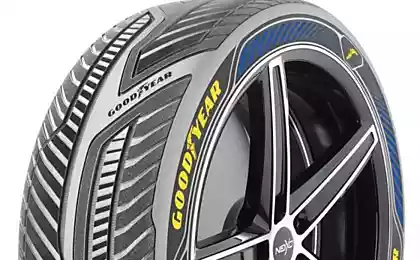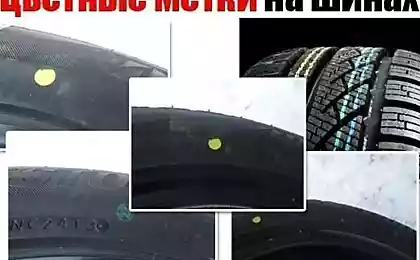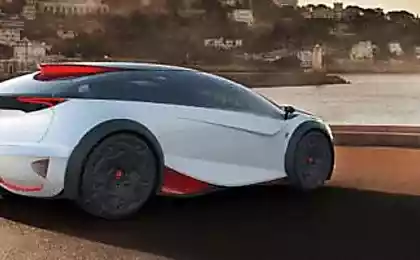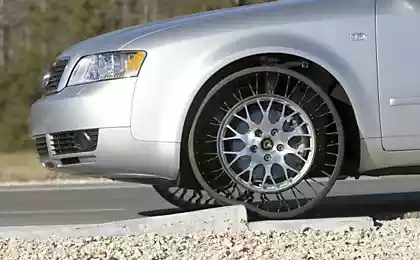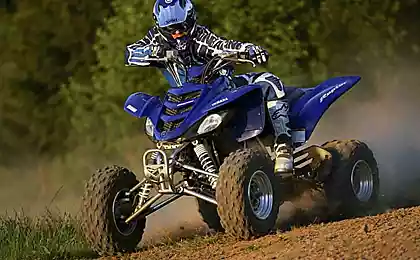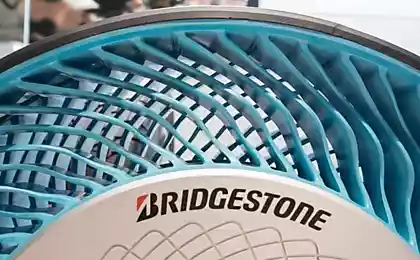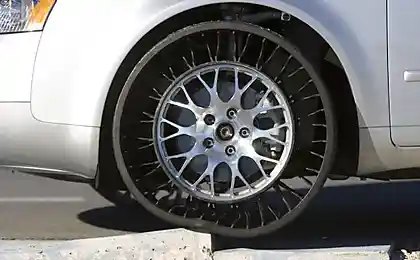886
Winter tires
Russian motorists, choosing between two types of "rubber", continue to focus on the "Tips experienced". That is, the vast majority of our readers said that the "spike" on pure asphalt behave badly (even dangerous) but indispensable on roads covered with ice or snow. And vice versa: if you ride on the groomed urban roads, you are only suitable "Velcro." What is this true? As it turned out, modern tires easily destroy stereotypes!
But first let's see what all are winter tires. About the new "spike" season "Winter-2013/2014," we have been told, and now the time has come for a short educational program "Velcro." The latter are divided on the "Arctic" (another name - "Scandinavian") and "European." The second type is the best choice for the inhabitants of warm regions, because of the characteristics more like a "vsesezonku" and works well only at near-zero temperatures. Therefore, for severe winter conditions is suitable only "Scandinavian" variety!
If you are afraid that the seller-deceiver sell "EUROSHIN" instead of "Scandinavian", remember a few rules. First, on their websites shinniki clarify that "rubber" is intended "to mild winter conditions." Secondly, "Scandinavia" is distinguished by a variety of small slots, slats, and angular soft tread "shoulders", while "Europeans" - a more rounded shape (of course, we are talking about a cross-section), and a hard - even to the touch! - Protector. Also it serves as a hallmark of the index rate. Tires for Europe faster and more marked with the letter «H» and «V» (respectively 210 and 240 km / h), and a model for the North can boast only the index «Q», «R» or «T» (160, 170, or 190 km / h). So far, the only exception are the Michelin X-Ice 3, which, in spite of the "nature of the Arctic", flaunt bukovkoy "N" on the sidewall.
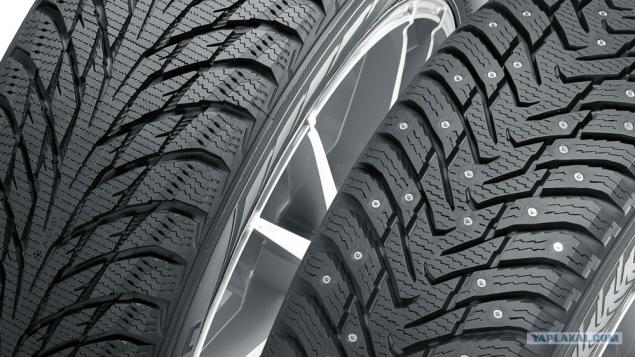
On pure asphalt
Next, we will consider only "Arctic tires." For a start, we find out: whether such "Velcro" far ahead "spike" on the "asphalt discipline"? Theory and leave finally beginning to see what the tests say bus respected automotive publications: Russian newspaper Autoreview and Finnish magazine Tekniikan Maailma. That's just one catch ... This year, experts Autoreview lit studded and friction tires for different groups of transcripts! However, colleagues clarify: to compare the results can be both championships, since the test took place at the same time, in exactly the same conditions.
In that discipline, which is considered to be a weak point "spikes" - "braking on wet pavement at a speed of 80 km / h" - tires were surprisingly strong! Look, have friction tires scatter of results from 33, 1 to 41, 1 m, and the results of the "toothed wheels" - from 35, 3 to 38, 7 m. That is, on the asphalt modern studded and studless "tires" brake roughly the same. And part of the "sticky" even lost the "spike"! For example, inexpensive Kama Euro-519 performed better than trendy Bridgestone Revo GZ and Yokohama IceGuard 50 ...

And "perestavke" on dry pavement (this exercise is also called "moose test") results are comparable - both varieties of "Rubber" is incredibly close to the level reached. The spread of indicators for "spikes" was 62, 4-60, 0 km / h, "sticky" - 63, 7-59, 7 km / h. Again parity! Although on dry pavement friction tires, of course, won. When braking from a speed of 80 km / h "friktsionki" left at 30, 2-33, 1 m, and "spikes" - 33, 5-35, 7. The difference between the "worst" and "best", you see, is not too large.
The results, which leads Tekniikan Maailma, the situation is similar. The final report of the exercises "Handling on wet pavement" and "braking on wet pavement," both types of winter tires listed mixed. Furthermore! The Finns even rides on dry coating showed no leader between the two types of wheels ... So to say that a certain category of "rubber" is preferable to the pavement, you can not: modern (again repeat the epithet!) "Spike" on the level not inferior friction " rubber ".
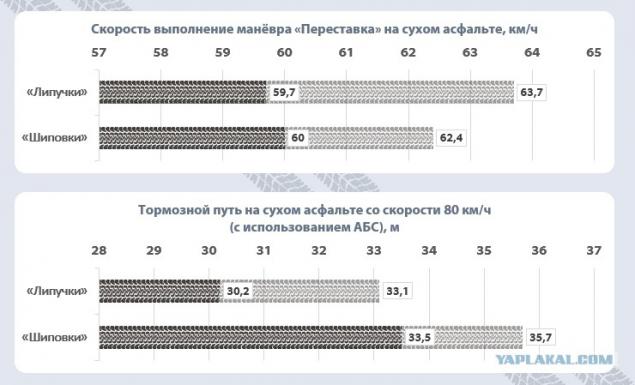
On a winter road
Perhaps, contrary to myth, friction tires suddenly shine in the snow and ice tests? Indeed! On the snow "tires" without thorns proved to be extremely competitive. According Autorevue, the acceleration to 50 km / h - in the range of 7, 7 to 9 and 5, and the "spikes" - 8, 7 to 10, 5, p. Albeit small, but there is a difference. Also, "toothless" tires a bit, but ahead of the "toothy" competitors while passing a winding road. In studless wheel Ladderpoints results - 90, 7-96, 3, the representatives of "profiled camps" - 91, 8-99, 2.
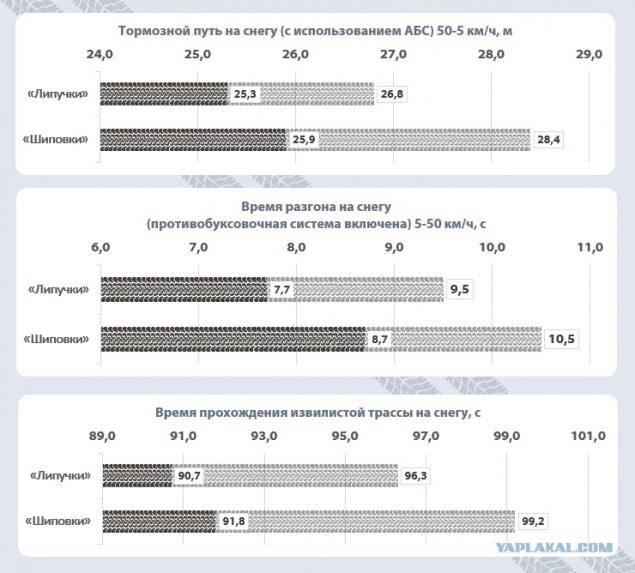
But compacted snow on the streets of Russian cities - a rare phenomenon. More often, the road covered with "slush" as the experts call the snow-water gruel. In such tire friction coating is much more stable! The best of "spikes" loses grip at speed 21, 2 km / h, and the worst of the "Velcro" pops up "gruel" depth of 35 mm only upon reaching 22, 6 km / h. So if your routes usually lie on the roads, where it is found complicit in the reactants water and mud substance must either choose the non-studded tires, or reduce speed. Otherwise - the loss of control, skid and crash.

On the ice, the situation is reversed. Here, the metal "hook" out of competition! To stop from a speed of 25 km / h, most of the "toothy" models require at least 13 m (exception - our Kama Euro-519, the result is 13, 5 m). In this standard among studless category missed only Pirelli and Nokian (12, 6, and 12, 8 m, respectively), the rest of the "Velcro" to perform this exercise, it took 13, 2 to 14, 8 m. By the way, to demonstrate the difference between the "Arctic" and "European" tires without studs, we present the result of DMACK WinterSafe: machine on these "European" wheels braked after 16, 2 m!
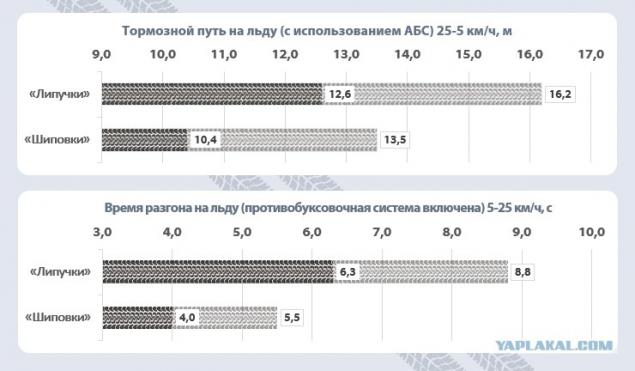
Other demonstration exercise - races on the icy roads. The less time, the high speed allows us to develop the tire when cornering and driving will be the safer. So, icy ring studded pass for 25, 8-29, 8 and studless - for 34, 3-38, 3. On the winding road from the worst "spikes" brought the result of 88, 3, and the best of the "sticky" - only 96, with 0. We test Tekniikan Maailma very similar data. At the bottom of the final protocol on all "Ice Ladder" - non-studded models. As the saying goes, that we wanted to prove.
And with measurements of noise - no surprises. According to Auto Review "spike" earned from 5 to 8 points out of 10 possible (and "eight" I had only one model - Michelin X-Ice North 2), according to Tekniikan Maailma - from 4 to 6 points as of 10. At the same time the Finns 'Velcro' polls were rated 9 and 10, while Russian experts only Nordman RS «grabbed" shameful for quiet friction wheel eight points, while all other models are also able to boast a perfect score. So fans of silence continues to recommend non-studded "tire": tire manufacturers are not yet able to make spikes quiet.
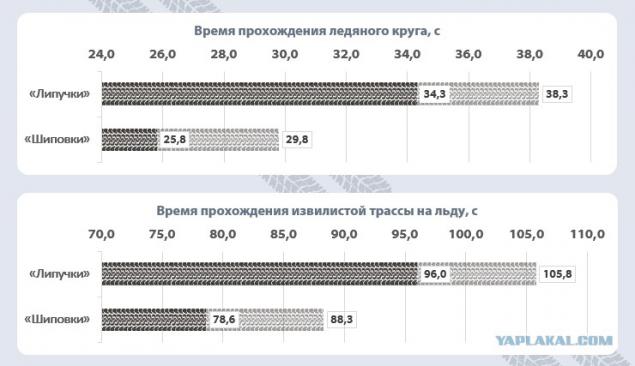
Theory without practice
And now let's see why the arguments of experienced drivers appeared errors. With spikes on solid surfaces is clear: it is assumed that studded asphalt is based on spikes, and not tread. In fact, the "rubber" is designed in such a way that the upper part of the metal "hook" when driving on asphalt recessed into the tread under the weight of the car! That is, the contact patch and "spikes", and "sticky" about the same. At the same tread rubber "teeth" more solid models (for good fastening spikes), so many models on the asphalt studded easily bypassed his fellow friction of soft rubber.
From the opposite effect, which is not noticed testers. And they could not notice the "ice" offsets tires "passed" at -14 ...- 17 ° C, "asphalt" - and all at plus thermometer readings. But in severe frost, when the temperature is lowered the mark of "-20", with studded tires occur unpleasant metamorphosis. First, the ice becomes so hard that "hooks" strongly recessed into the tread - the car remains virtually no thorns! (Do not think for advertising, but so far the only brand that has found a solution to this problem is Michelin.) Second, tough tread rubber becomes "oak", causing the clutch is also deteriorating. And on the ice and on the asphalt.
It turns out that the "big red" soft studless tires often provide a more secure driving. By the way, in the comments of many of our readers from Siberia we noted that the drive is on the "Velcro." Say, in the extreme cold this "rubber" is preferable. Confirm that they are absolutely right! Also, right, those drivers who choose "friktsionki" for the urban environment. On the snow (ie, in the courts, where poorly cleaned public utilities) and snow-water mash, mixed with the reagents, tires without studs show much more convincing results.
However, the city of the city alike. In some settlements the road more like a skating rink. And then, as shown by the test and Autoreview Tekniikan Maailma, without thorns can not do. No matter how trying to tire manufactures, ice remains the weak point of friction models in this discipline, even the best news is only trying to catch up with the classic "spike" ... And so the position of some motorists who rarely venture beyond the treated arteries, but the ruble vote only for "toothed" tires, is justified: who knows where to meet black ice? However, for such insurance have to pay constant noise and increased fuel consumption.
Posted in [mergetime] 1383643828 [/ mergetime]
Well, I think it is a useful material))
TOP-5 friction tires
According to Auto Review:
Nokian Hakkapeliitta R2
Pirelli Winter Ice Control
Continental ContiVikingContact
Bridgestone Revo GZ
Michelin X-Ice 3
According to Tekniikan Maailma:
Michelin X-Ice 3
Nokian Hakkapeliitta R2
Bridgestone Blizzak WS70
Pirelli Winter Ice Control
Continental ContiVikingContact
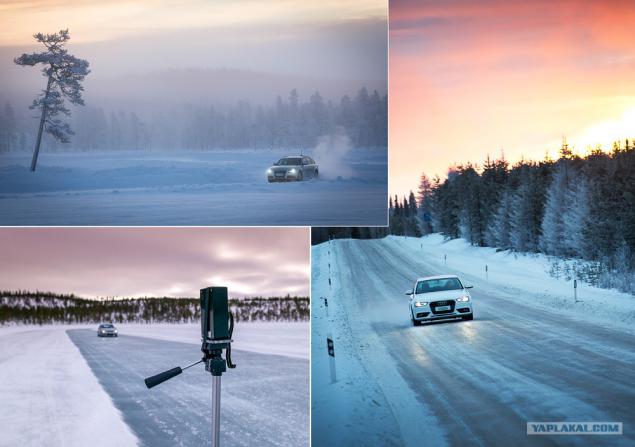
Source:
But first let's see what all are winter tires. About the new "spike" season "Winter-2013/2014," we have been told, and now the time has come for a short educational program "Velcro." The latter are divided on the "Arctic" (another name - "Scandinavian") and "European." The second type is the best choice for the inhabitants of warm regions, because of the characteristics more like a "vsesezonku" and works well only at near-zero temperatures. Therefore, for severe winter conditions is suitable only "Scandinavian" variety!
If you are afraid that the seller-deceiver sell "EUROSHIN" instead of "Scandinavian", remember a few rules. First, on their websites shinniki clarify that "rubber" is intended "to mild winter conditions." Secondly, "Scandinavia" is distinguished by a variety of small slots, slats, and angular soft tread "shoulders", while "Europeans" - a more rounded shape (of course, we are talking about a cross-section), and a hard - even to the touch! - Protector. Also it serves as a hallmark of the index rate. Tires for Europe faster and more marked with the letter «H» and «V» (respectively 210 and 240 km / h), and a model for the North can boast only the index «Q», «R» or «T» (160, 170, or 190 km / h). So far, the only exception are the Michelin X-Ice 3, which, in spite of the "nature of the Arctic", flaunt bukovkoy "N" on the sidewall.

On pure asphalt
Next, we will consider only "Arctic tires." For a start, we find out: whether such "Velcro" far ahead "spike" on the "asphalt discipline"? Theory and leave finally beginning to see what the tests say bus respected automotive publications: Russian newspaper Autoreview and Finnish magazine Tekniikan Maailma. That's just one catch ... This year, experts Autoreview lit studded and friction tires for different groups of transcripts! However, colleagues clarify: to compare the results can be both championships, since the test took place at the same time, in exactly the same conditions.
In that discipline, which is considered to be a weak point "spikes" - "braking on wet pavement at a speed of 80 km / h" - tires were surprisingly strong! Look, have friction tires scatter of results from 33, 1 to 41, 1 m, and the results of the "toothed wheels" - from 35, 3 to 38, 7 m. That is, on the asphalt modern studded and studless "tires" brake roughly the same. And part of the "sticky" even lost the "spike"! For example, inexpensive Kama Euro-519 performed better than trendy Bridgestone Revo GZ and Yokohama IceGuard 50 ...

And "perestavke" on dry pavement (this exercise is also called "moose test") results are comparable - both varieties of "Rubber" is incredibly close to the level reached. The spread of indicators for "spikes" was 62, 4-60, 0 km / h, "sticky" - 63, 7-59, 7 km / h. Again parity! Although on dry pavement friction tires, of course, won. When braking from a speed of 80 km / h "friktsionki" left at 30, 2-33, 1 m, and "spikes" - 33, 5-35, 7. The difference between the "worst" and "best", you see, is not too large.
The results, which leads Tekniikan Maailma, the situation is similar. The final report of the exercises "Handling on wet pavement" and "braking on wet pavement," both types of winter tires listed mixed. Furthermore! The Finns even rides on dry coating showed no leader between the two types of wheels ... So to say that a certain category of "rubber" is preferable to the pavement, you can not: modern (again repeat the epithet!) "Spike" on the level not inferior friction " rubber ".

On a winter road
Perhaps, contrary to myth, friction tires suddenly shine in the snow and ice tests? Indeed! On the snow "tires" without thorns proved to be extremely competitive. According Autorevue, the acceleration to 50 km / h - in the range of 7, 7 to 9 and 5, and the "spikes" - 8, 7 to 10, 5, p. Albeit small, but there is a difference. Also, "toothless" tires a bit, but ahead of the "toothy" competitors while passing a winding road. In studless wheel Ladderpoints results - 90, 7-96, 3, the representatives of "profiled camps" - 91, 8-99, 2.

But compacted snow on the streets of Russian cities - a rare phenomenon. More often, the road covered with "slush" as the experts call the snow-water gruel. In such tire friction coating is much more stable! The best of "spikes" loses grip at speed 21, 2 km / h, and the worst of the "Velcro" pops up "gruel" depth of 35 mm only upon reaching 22, 6 km / h. So if your routes usually lie on the roads, where it is found complicit in the reactants water and mud substance must either choose the non-studded tires, or reduce speed. Otherwise - the loss of control, skid and crash.

On the ice, the situation is reversed. Here, the metal "hook" out of competition! To stop from a speed of 25 km / h, most of the "toothy" models require at least 13 m (exception - our Kama Euro-519, the result is 13, 5 m). In this standard among studless category missed only Pirelli and Nokian (12, 6, and 12, 8 m, respectively), the rest of the "Velcro" to perform this exercise, it took 13, 2 to 14, 8 m. By the way, to demonstrate the difference between the "Arctic" and "European" tires without studs, we present the result of DMACK WinterSafe: machine on these "European" wheels braked after 16, 2 m!

Other demonstration exercise - races on the icy roads. The less time, the high speed allows us to develop the tire when cornering and driving will be the safer. So, icy ring studded pass for 25, 8-29, 8 and studless - for 34, 3-38, 3. On the winding road from the worst "spikes" brought the result of 88, 3, and the best of the "sticky" - only 96, with 0. We test Tekniikan Maailma very similar data. At the bottom of the final protocol on all "Ice Ladder" - non-studded models. As the saying goes, that we wanted to prove.
And with measurements of noise - no surprises. According to Auto Review "spike" earned from 5 to 8 points out of 10 possible (and "eight" I had only one model - Michelin X-Ice North 2), according to Tekniikan Maailma - from 4 to 6 points as of 10. At the same time the Finns 'Velcro' polls were rated 9 and 10, while Russian experts only Nordman RS «grabbed" shameful for quiet friction wheel eight points, while all other models are also able to boast a perfect score. So fans of silence continues to recommend non-studded "tire": tire manufacturers are not yet able to make spikes quiet.

Theory without practice
And now let's see why the arguments of experienced drivers appeared errors. With spikes on solid surfaces is clear: it is assumed that studded asphalt is based on spikes, and not tread. In fact, the "rubber" is designed in such a way that the upper part of the metal "hook" when driving on asphalt recessed into the tread under the weight of the car! That is, the contact patch and "spikes", and "sticky" about the same. At the same tread rubber "teeth" more solid models (for good fastening spikes), so many models on the asphalt studded easily bypassed his fellow friction of soft rubber.
From the opposite effect, which is not noticed testers. And they could not notice the "ice" offsets tires "passed" at -14 ...- 17 ° C, "asphalt" - and all at plus thermometer readings. But in severe frost, when the temperature is lowered the mark of "-20", with studded tires occur unpleasant metamorphosis. First, the ice becomes so hard that "hooks" strongly recessed into the tread - the car remains virtually no thorns! (Do not think for advertising, but so far the only brand that has found a solution to this problem is Michelin.) Second, tough tread rubber becomes "oak", causing the clutch is also deteriorating. And on the ice and on the asphalt.
It turns out that the "big red" soft studless tires often provide a more secure driving. By the way, in the comments of many of our readers from Siberia we noted that the drive is on the "Velcro." Say, in the extreme cold this "rubber" is preferable. Confirm that they are absolutely right! Also, right, those drivers who choose "friktsionki" for the urban environment. On the snow (ie, in the courts, where poorly cleaned public utilities) and snow-water mash, mixed with the reagents, tires without studs show much more convincing results.
However, the city of the city alike. In some settlements the road more like a skating rink. And then, as shown by the test and Autoreview Tekniikan Maailma, without thorns can not do. No matter how trying to tire manufactures, ice remains the weak point of friction models in this discipline, even the best news is only trying to catch up with the classic "spike" ... And so the position of some motorists who rarely venture beyond the treated arteries, but the ruble vote only for "toothed" tires, is justified: who knows where to meet black ice? However, for such insurance have to pay constant noise and increased fuel consumption.
Posted in [mergetime] 1383643828 [/ mergetime]
Well, I think it is a useful material))
TOP-5 friction tires
According to Auto Review:
Nokian Hakkapeliitta R2
Pirelli Winter Ice Control
Continental ContiVikingContact
Bridgestone Revo GZ
Michelin X-Ice 3
According to Tekniikan Maailma:
Michelin X-Ice 3
Nokian Hakkapeliitta R2
Bridgestone Blizzak WS70
Pirelli Winter Ice Control
Continental ContiVikingContact

Source:






